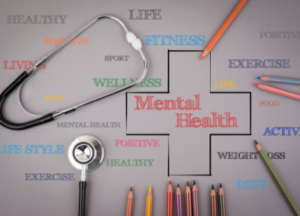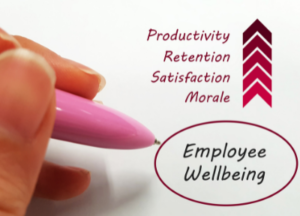
by admin | May 10, 2022 | Health & Wellness, Hot Topics
 “Suck it up,” “cheer up,” “snap out of it,” “but you don’t look sick”- these are just some of the phrases that well-meaning friends and family tell loved ones struggling with mental health issues. Research shows that one in five adults struggle with mental health conditions. Mental health struggles include depression, bipolar disorder, anxiety, schizophrenia, and eating disorders.
“Suck it up,” “cheer up,” “snap out of it,” “but you don’t look sick”- these are just some of the phrases that well-meaning friends and family tell loved ones struggling with mental health issues. Research shows that one in five adults struggle with mental health conditions. Mental health struggles include depression, bipolar disorder, anxiety, schizophrenia, and eating disorders.
Mental illness is also becoming increasingly common among teenagers; studies indicate that approximately one in five teens between ages twelve and eighteen are diagnosed with a mental health disorder. These issues deeply impact day-to-day living and may also affect the ability to relate to others. When your mental health suffers, everything in your life will suffer as a result.
What is Mental Health?
Mental health includes our emotional, psychological, and social well-being. It affects how we think, feel, and act. It also helps determine how we handle stress, relate to others, and make choices.
The fact is, a mental illness is a disorder of the brain – your body’s most important organ. Like most diseases of the body, mental illness has many causes – from genetics to other biological, environmental and social/cultural factors. And just as with most diseases, mental illnesses are no one’s fault. For many people, recovery – including having meaningful roles in social life, work and school – is possible, especially when you start treatment early and play a strong role in your own recovery process.
What Are the Warning Signs?
Each illness has its own symptoms, but common signs of mental illness can include the following:
- Avoiding friends and social activities
- Feeling excessively sad or low
- Feeling helpless or hopeless
- Extreme mood changes
- Thinking of harming yourself or others
- Inability to perform daily tasks like taking care of your kids or getting to work or school
- Feeling numb or like nothing matters
- Overuse of substances like alcohol or drugs
- Having unexplained aches and pains such as headaches or stomach aches
- Changes in sleeping habits or feeling tired and low energy
- Feeling unusually confused, forgetful, on edge, angry, upset, worried, or scared
What Are Some Things You Can Do to Look After Your Mental Health?
- Talk About Your Feelings – Just being listened to can help you feel supported and less alone. Talking with a friend or loved one is helpful but remember, therapists are not only for those in the middle of crisis – they’re incredibly beneficial for people in all stages of life
- Exercise regularly – Exercise releases endorphins, which have mood-boosting effects. Aim to exercise about 30+ minutes at least five days per week
- Eat Well – Your brain needs a mix of nutrients to stay healthy and function well, just like the other organs in your body
- Stay Connected with Family and Friends – Close, quality relationships are key for a happy, healthy life
- Take a Break – a change of scenery or pace is good for your mental health
- Get Outside to Enjoy 15 Minutes of Sunshine – Sunlight synthesizes Vitamin D which experts believe is a mood elevator
- Send a Thank You Note – Let someone know why you appreciate them. Written expressions of gratitude are linked to increased happiness
- Practice Forgiveness – People who forgive have better mental health and report being more satisfied with their lives
- Pursue Your Passions – Enjoying yourself can help beat stress and achieving something boosts your self-esteem
- Sleep – Most adults need around 8 hours of sleep each night so try to make sure you’re getting enough shut-eye
Mental health is undoubtedly just as integral as physical health but it’s something that we often don’t prioritize. We all experience times when we feel stressed or overwhelmed but if these feelings persist, it’s time to slow down and re-evaluate your mental wellbeing.
Most people are afraid to ask for help, but seeking help is actually a sign of strength, not weakness. If you or someone you know is struggling with their mental health, please reach out to a local mental health professional.

by admin | Mar 21, 2022 | Health & Wellness, Human Resources, Workplace
 Question
Question
We’ve been both super busy and understaffed recently. Is there anything we can do during this time to help our employees avoid extra stress or burnout before we can hire more employees?
Answer
Yes. Here are a few things you can do to make this time run as smoothly and stress-free as possible:
Remove nonessential work duties: For the positions that seem most stretched, make a list of tasks that could be put on hold (or perhaps reassigned). You can invite input from employees, too, but I’d recommend acknowledging that they’re overwhelmed and saying that you’ll do your best to alleviate some of the pressure. Then hold off on nonessential tasks until business slows down or you’ve increased your headcount.
Allow for flexible scheduling: If employees need to work longer hours on some days during the week, consider allowing them to work fewer hours on other days of the week. Note that some states have daily overtime, spread-of-hours, or split-shift laws.
Budget for overtime: Employees may need to work extra hours to keep up with the current demands of their job, so allow them to work overtime if you (and they) can swing it. If you’re pretty sure overtime will be necessary, inform employees of that ahead of time, so they can plan accordingly.
Ensure all equipment is fast and reliable: It’s important to identify, troubleshoot, and correct any slow or nonworking equipment issues (such as laptops, internet hardware, cash registers, or vehicles). If not resolved, these issues can slow down work and add to everyone’s stress.
Look for ways to automate: Consider whether any of your employees’ manual and time-consuming tasks could be eliminated or simplified with the use of new or different technology.
Increase safety protocols: Employee absences related to COVID have created a significant strain for many employers during the pandemic. Shoring up your safety protocols may reduce the risk of COVID-related absences because of sickness or exposure. Depending on your circumstances, examples include improving ventilation, encouraging or requiring vaccination, requiring employees to wear masks, and allowing employees to work remotely when possible.
By Megan Lemire
Originally posted on Mineral

by admin | Feb 9, 2022 | Health & Wellness
 Workplace wellness programs have increased in the past several years to promote healthy diets and lifestyle, exercise and other behaviors such as quitting smoking. As of 2020, most employers had wellness programs of some kind, including 53% of small firms (those with 3-200 employees) and 81% of large companies. Since employees spend most of their waking hours on the job, wellness programs seem to be a natural fit to try to promote healthy changes in behavior. But, in 2022, employees want more; many workers are looking for employers who show authentic concern for their well-being.
Workplace wellness programs have increased in the past several years to promote healthy diets and lifestyle, exercise and other behaviors such as quitting smoking. As of 2020, most employers had wellness programs of some kind, including 53% of small firms (those with 3-200 employees) and 81% of large companies. Since employees spend most of their waking hours on the job, wellness programs seem to be a natural fit to try to promote healthy changes in behavior. But, in 2022, employees want more; many workers are looking for employers who show authentic concern for their well-being.
Well-being is about how our lives are going. It’s not only about health and happiness but also about living life to its fullest potential. In fact, data shows that employees of all generations rank “the organization cares about the employees’ well-being” in their top three criteria.
Financial stress soared during the pandemic but so did regular stress, too. Mental health struggles such as anxiety, depression, and substance abuse are also climbing. These are expensive issues to ignore both in terms of the human suffering but also the company’s bottom line: Depression alone costs an estimated $210.5 billion per year. These costs are due to absenteeism (missed work days) and presenteeism (reduced productivity at work) as well as direct medical costs (outpatient and inpatient medical services and pharmacy costs).
Employers must recognize the interrelationship between the physical, financial, work and well-being components of employees’ lives. For example, employees who need help with their financial well-being are significantly less likely to be physically healthy and more likely to report feeling stressed or anxious which can impact productivity and job performance. Vice President for Communications at Fidelity Investments in Boston, Mike Shamrell, recognizes the need for all dimensions of wellness. “It’s tough to be well in one area when you’re unwell in another,” he said.
Well-being is often associated with gym memberships and green smoothies but it is much more than that; it is a result of many different aspects of one’s life. Here are 5 common dimensions of well-being that can be addressed through a workplace wellness program:
- Emotional/Mental Health – Understanding your feelings and coping with stress.
- Physical Health – Discovering how self-care can improve your life and productivity.
- Financial Health – Successfully managing your money.
- Social Connectedness – Creating and being a part of a support network.
- Occupational Well-Being– Feeling appreciated at work and satisfied in your contributions.
Great employees want great employers. Companies that want creative, high-performing teams must be willing to support workers both in and out of the office. Well-being has a major influence on an employee’s performance and satisfaction; employees who feel valued and appreciated are more invested in their company in return.

by admin | Dec 7, 2021 | Hot Topics
 “Children laughing, people passing, meeting smile after smile” stirs happy memories of singing Christmas carols for some, but for others, the holidays can be the most stressful and loneliest time of the year. The holidays often present a dizzying array of demands – shopping, baking, and entertaining to name a few. For those dealing with mental health conditions like depression or or anxiety, the holidays can be even harder.
“Children laughing, people passing, meeting smile after smile” stirs happy memories of singing Christmas carols for some, but for others, the holidays can be the most stressful and loneliest time of the year. The holidays often present a dizzying array of demands – shopping, baking, and entertaining to name a few. For those dealing with mental health conditions like depression or or anxiety, the holidays can be even harder.
Holiday depression can be misinterpreted as being nothing more than the winter blues. So, when it comes to the holidays, people are more focused on their physical health issues instead of their mental health issues. They are more interested in losing weight than taking care of their mental health. Being unaware that there is a problem can make holiday depression evolve into major depression. Counseling and medication are good avenues to seek if you are living with symptoms of depression.
Here are 9 tips that you can use to help you with holiday depression:
- Be realistic – Holidays change just as people change. Kids grow older, people move, and new people will become a part of your life. Focus on those connections, new traditions and remember past holidays with fondness while still enjoying the one right in front of you.
- Schedule Some Down-Time – Even 15-20 minutes a day to enjoy some quiet time, take a bath, listen to music or read a book can do wonders for your stress levels. Plus, it’s ok to say no: you don’t have to attend every party or family event.
- Don’t Isolate Yourself – Look for ways that you can enjoy social connections, even if you aren’t able to go home for the holidays. If you are feeling lonely, ask a friend to come over for a heart to heart or volunteer for something that interests you.
- Drink Only in Moderation – Alcohol is a depressant and can exacerbate negative feelings.
- Exercise Regularly – While hitting the gym can be tough when you are stressed and busy, try going for a short walk. Did you know that exercise can help relieve symptoms of depression?
- Focus on the Positives – Today is a gift. That is why it’s called the present! Being positive and practicing gratitude has a strong positive impact on psychological well-being. It increases self-esteem, enhances positive emotions and makes us more optimistic.
- Keep Expectations Manageable – Try to set realistic goals for yourself and your family. Pace yourself. Organize your time and make a list and prioritize the important activities.
- Let People Close to You Know What’s Going On – Don’t try to hide your holiday depression from your friends and family. Hiding your problem can make your mental health worse. Instead, be honest with them and let them know what you are going through and make sure you let them know that you don’t expect them to make it better.
- Seek Professional Help if You Need It – You may find yourself feeling persistently sad or anxious, unable to sleep, unable to face routine chores or irritable and hopeless despite your best efforts. If these feelings last for a while, talk to your doctor or a mental health professional.
Avoid beating yourself up if you are not full of the “joy of the season.” With some planning, self-care and social connections, it’s possible to tackle depression around the holidays and still enjoy the season. Be gentle with yourself, have realistic expectations, and don’t abandon your healthy habits just because it’s the holiday season. By actively working to manage your mental health, you will be able to make the best of the holidays!
If you are experiencing these symptoms over a period of several weeks, you may be depressed. Talking with a mental health professional or taking a mental health screening test can help you understand how well you are coping with recent events. Seek help.

by admin | Jun 24, 2021 | Human Resources
 There are certain issues that have taken center stage in the collective conscious when talking about the workplace, the future of work and how the current workforce is faring under the current conditions. Naturally, as those things enter the collective conscious, researchers find themselves asking what exactly holds true and what can we learn from it?
There are certain issues that have taken center stage in the collective conscious when talking about the workplace, the future of work and how the current workforce is faring under the current conditions. Naturally, as those things enter the collective conscious, researchers find themselves asking what exactly holds true and what can we learn from it?
As usual, my inbox is full of the latest studies and surveys being conducted by HR vendors, researchers and employers of all sizes. In today’s data drop, we’re going to take a closer look at how employees view diversity and inclusion efforts, what challenges they’re facing when it comes to mental health and the impact the gig economy is having.
The D&I Appetite
At this point, there should be little doubt around the importance of D&I or DEI in your organization. It’s been well established the impact it has on the bottom line and employer brands, but if you needed more reassurance, the latest study from Boston Consulting Group should hammer it home.
The study asked questions of more than 200,000 employees across 190 countries and the results shouldn’t come as a surprise to anyone who’s been following sentiments around DEI over the last year. Results included the following:
- More than half (51%) of U.S. respondents said they would exclude a company from their job search if its values and stance on diversity and inclusion (D&I) didn’t match their own beliefs. This number was even higher among respondents 30 years and younger (56%).
- D&I became more important over the last year across all age groups globally. In the U.S., respondents 30 years and younger (72%) were most likely to agree with this statement compared to all U.S. respondents (63%) and all respondents globally (69%).
It’s a notable sentiment following the release of research by diversity platform Headstart as part of its “Discrimination in American Hiring” report. The findings show that 54% of those seeking a new job in the last two years felt they were frequently discriminated against. That number rose to 66% for Black Americans and 83% for those who identify as gender-diverse. Interestingly, however, 30% of respondents who faced recruitment discrimination would consider reapplying for the same company.
Mental Health Struggles
In June of last year, the Centers for Disease Control and Prevention (CDC) released data which showed that 40% of Americans were struggling with mental health. That number hasn’t decreased as the pandemic has continued and the months that followed included a hectic election and numerous other crises.
A more recent report from The Standard, an Oregon based insurance company, showed that 55% of workers surveyed said that a mental health issue had affected them more since the pandemic began. MetLife’s annual Employee Benefits Trends Study backs this up, with 54% saying mental health has been their biggest concern during the pandemic.
This won’t come as a surprise to HR teams that have been working toward developing mental health support tools for their workforces, but it should also be extended to talent teams as they consider their hiring processes.
Among the unemployed, one in five are or have been treated for depression in the last year. Many suffer from sleep loss and high levels of stress that can impact their ability to search and interview for a new job. Long term unemployment can lead to serious health issues such as obesity and other conditions related to stress and inactive lifestyle.
Expanding Gig Economy
Globally the gig economy has seen a boom as layoffs and needs for flexible scheduling have seen more people around the world adopt gig work than ever before. In the U.S., around 40% of Americans are currently working in gig or contract roles.
Job boards are now seeing a stark rise in contract job postings, with Resume-Library noting a 58% increase in the demand for handyman roles month over month. While many think of rideshare drivers and freelancer graphic artists when they think of gig work, the top five gig postings on the site now include the following:
- Handyman +58.3%
- Market Researcher +50%
- Packer +20.3%
- Social Media +4.5%
- Photographer +4.3%
The U.S. is currently the fastest growing freelance market in the world, experiencing a 78% growth in gig positions over the last year, with the UK following behind at 59% and Brazil at 48%.
By David Rice
Originally posted on ThinkHR

 “Suck it up,” “cheer up,” “snap out of it,” “but you don’t look sick”- these are just some of the phrases that well-meaning friends and family tell loved ones struggling with mental health issues. Research shows that one in five adults struggle with mental health conditions. Mental health struggles include depression, bipolar disorder, anxiety, schizophrenia, and eating disorders.
“Suck it up,” “cheer up,” “snap out of it,” “but you don’t look sick”- these are just some of the phrases that well-meaning friends and family tell loved ones struggling with mental health issues. Research shows that one in five adults struggle with mental health conditions. Mental health struggles include depression, bipolar disorder, anxiety, schizophrenia, and eating disorders.



